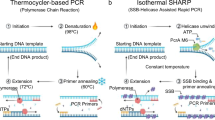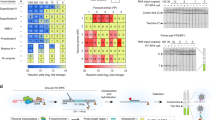Abstract
We demonstrate the utility of antibodies to the DNA polymerase from Thermus aquaticus (TaqPol) as thermolabile inhibitors of TaqPol activity. One of the limitations of the polymerase chain reaction (PCR) is the co-amplification of non-specific products caused by TaqPol activity on low stringency templates present in the initial cycle of PCR. We have used anti-TaqPol antibodies as thermolabile switches that inhibit TaqPol activity at low temperatures (20–40°C) and release fully active TaqPol when they are inactivated by elevated temperatures in the PCR thermal cycling (70–98°C). Several in a set of high affinity anti-TaqPol monoclonal antibodies fully inhibited TaqPol activity at 37°C. The capacity for inhibition was ablated by incubation at temperatures high enough to denature antibodies but not sufficiently high to significantly reduce TaqPol activity. In a PCR model system, preincubation of TaqPol with these antibodies yielded PCR product consisting entirely of the intended product and the absence or significant reduction of non-specific products and primer dimers. In evaluation of clinical samples such antibody triggering yielded defined PCR product and higher sensitivity because of the absence of non-specific products.
This is a preview of subscription content, access via your institution
Access options
Subscribe to this journal
Receive 12 print issues and online access
$209.00 per year
only $17.42 per issue
Buy this article
- Purchase on Springer Link
- Instant access to full article PDF
Prices may be subject to local taxes which are calculated during checkout
Similar content being viewed by others
References
Erlich, H.A., Gelfand, D. and Sninsky, J.J. 1991. Recent advances in the polymerase chain reaction. Science 252: 1643–1651.
Amheim, N. and Erlich, H. 1992. Polymerase chain reaction strategy. Annu. Rev. Biochem. 61: 131–156.
Mullis, K.B. 1991. The polymerase chain reaction in an anemic mode: How to avoid cold oligodeoxyribonuclear fusion. PCR Methods Appl. 1: 1–4.
Mullis, K.B. and Faloona, F.A. 1987. Specific synthesis of DNA in vitro via a polymerase-catalyzed chain reaction. Methods Enzymol. 155: 335–350.
Chou, Q., Russell, M., Birch, D.E., Raymond, J. and Bloch, W. 1992. Prevention of pre-PCR mis-priming and primer dimerization improves low-copy-number amplifications. Nucl. Acids Res. 20: 1717–1723.
Hébert, B., Bergeron, J., Potworowski, E. and Tijssen, P. 1993. Increased PCR sensitivity by using paraffin wax as a reaction mix overlay. Mol. Cell. Probes. 7: 249–252.
Kwok, S., Kinard, S., Spadora, J. and Sninsky, J. 1992. “Enhancement of PCR specificity by uracil-N-glycosylase”, VII Int. Conference on AIDS/III S.T.D. World Congress. Abstracts.
Scalice, E.R., Sharkey, D.J. and Daiss, J.L. 1994. Monoclonal antibodies prepared against the DNA polymerase from Thermus aquaticus are potent inhibitors of enzyme activity. J. Immunol. Meth. In press.
Shami, E.Y., Ramjeesingh, M., Rothstein, A. and Zywulko, M. 1991. Stabilization of enzymes by their specific antibodies. Enzyme Microbiol. Technol. 13: 424–429.
Barany, F. 1991. Genetic disease detection and DNA amplification using cloned thermostable ligase. Proc. Natl. Acad. Sci. USA 88: 189–193.
Ou, C.-Y., Kwok, S., Mitchell, S.W., Mack, D.H., Sninsky, J.J., Krebs, J.W., Feorino, P., Warfield, D. and Schochetman, G. 1988. DNA amplification for direct detection of HIV-I in DNA of peripheral blood mononuclear cells. Science 239: 295–297.
Abbott, M.A., Poiesz, B.J., Byrne, B.C., Kwok, S., Sninsky, J.J. and Ehrlich, G.D. 1988. Enzymatic gene amplification: qualitative and quantitative methods for detecting proviral DNA amplified in vitro. J. Infect. Dis. 158: 1158–1169.
Findlay, J.B., Atwood, S.M., Bergmeyer, L., Chemelli, J. et al. 1993. Automated closed-vessel system for in vitro diagnostics based on polymerase chain reaction. Clin. Chem. 39: 1927–1933.
Author information
Authors and Affiliations
Rights and permissions
About this article
Cite this article
Sharkey, D., Scalice, E., Christy, K. et al. Antibodies as Thermolabile Switches: High Temperature Triggering for the Polymerase Chain Reaction. Nat Biotechnol 12, 506–509 (1994). https://doi.org/10.1038/nbt0594-506
Received:
Accepted:
Issue Date:
DOI: https://doi.org/10.1038/nbt0594-506
This article is cited by
-
Impact of Polymerase Fidelity on Background Error Rates in Next-Generation Sequencing with Unique Molecular Identifiers/Barcodes
Scientific Reports (2019)
-
Heat denaturation of the antibody, a multi-domain protein
Biophysical Reviews (2018)
-
Hot start reverse transcriptase: an approach for improved real-time RT-PCR performance
Journal of Analytical Science and Technology (2015)
-
Overview of thermostable DNA polymerases for classical PCR applications: from molecular and biochemical fundamentals to commercial systems
Applied Microbiology and Biotechnology (2013)
-
Rate of infection ofIxodes ricinus ticks withBorrelia burgdorferi sensu stricto,Borrelia garinii,Borrelia afzelii and group VS116 in an endemic focus of Lyme disease in Italy
European Journal of Clinical Microbiology & Infectious Diseases (1998)



